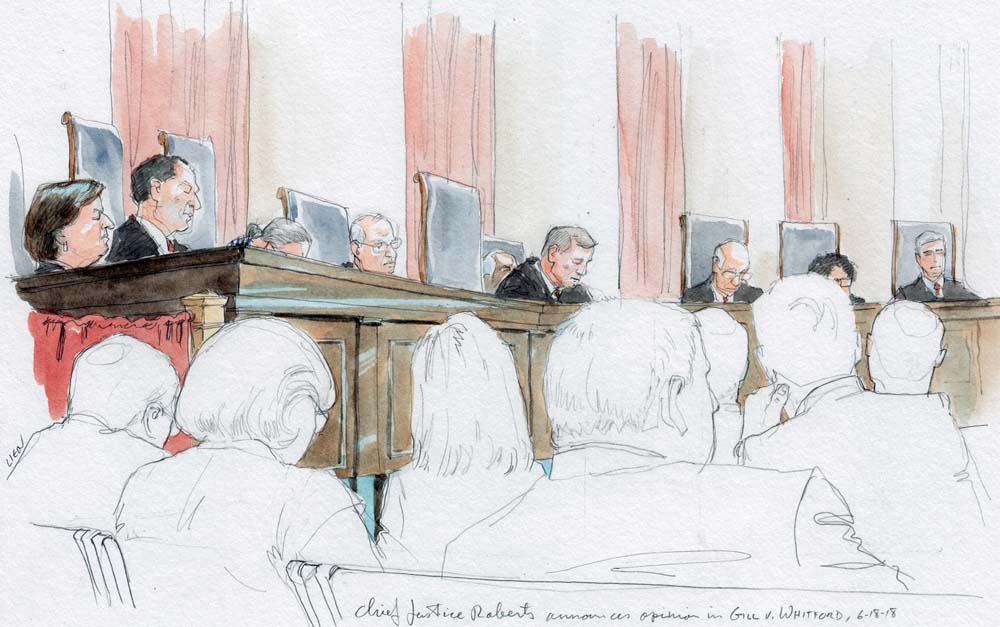Symposium: The Supremes put off deciding whether politics violates the Constitution

on Jun 19, 2018 at 6:42 pm

Hans A. von Spakovsky is a senior legal fellow at The Heritage Foundation and former counsel to the Assistant Attorney General for Civil Rights at the Justice Department. He is the coauthor of “Who’s Counting? How Fraudsters and Bureaucrats Put Your Vote at Risk” and “Obama’s Enforcer: Eric Holder’s Justice Department.”
Election lawyers, state legislators and political junkies were surely all disappointed on June 18 when the Supreme Court, in a unanimous opinion authored by Chief Justice John Roberts, avoided deciding whether partisan gerrymandering violates the Constitution. Instead, it sent the Gill v. Whitford case arising out of Wisconsin back to the lower court, holding that the plaintiffs had failed to demonstrate Article III standing because they had not shown any specific, individual injury to their right to vote.
The Supreme Court also issued a per curiam opinion in a similar case out of Maryland. In Benisek v. Lamone, the court held that the district court had not abused its discretion in denying a preliminary injunction to the plaintiffs while awaiting the court’s decision in Gill.
In remanding the Gill case, the justices temporarily avoided opening up a political thicket that could have flooded federal courts with redistricting claims, transforming them “into weapons of political warfare,” as Justice Samuel Alito put it last year in Cooper v. Harris, a North Carolina redistricting decision.
The plaintiffs in Gill were 12 Democratic voters who challenged the state legislative redistricting plan drawn by Wisconsin’s Republican-controlled legislature. They alleged that the statewide plan unfairly favored Republican voters and candidates by “cracking” and “packing” Democratic voters in order to diminish “the ability of Wisconsin Democrats to convert Democratic voters into Democratic seats in the legislature.” As they explained to the Supreme Court:
Cracking means dividing a party’s supporters among multiple districts so that they fall short of a majority in each one. Packing means concentrating one party’s backers in a few districts that they win by overwhelming margins.
The lead plaintiff, William Whitford, conceded at trial that because he lives in a heavily Democratic district in Madison, the statewide redistricting plan did not affect his “ability to vote for and elect a Democrat in [his] district.” But he and the other plaintiffs argued that whether or not they lived in a packed or cracked district, they had been harmed because Democrats statewide “do not have the same opportunity provided to Republicans to elect representatives of their choice to the Assembly.” Such partisan gerrymandering, the plaintiffs claimed, violated their First Amendment right of association and their 14th Amendment right to equal protection.
According to the plaintiffs, the “degree to which packing and cracking has favored one party over another” could be determined by a standard they called the “efficiency gap” that supposedly measures “wasted votes.” “Wasted votes” are votes “cast for a losing candidate or for a winning candidate in excess of what that candidate needs to win.” Because the efficiency gap is ultimately based on comparing the number of seats in a legislature with the number of statewide votes that different parties get, it is in essence a call for proportional representation.
Wisconsin’s experts testified that the efficiency gap is an “unreliable” measure of “durable partisan advantage” and that political geography currently favors Republicans over Democrats in the state. That is because “Democrats – who tend to be clustered in large cities – are inefficiently distributed in many parts of Wisconsin for purposes of winning elections.”
The three-judge district court panel found in favor of the plaintiffs, with a dissent by Judge William Griesbach. He pointed out that under the Supreme Court’s precedents, a partisan intent to “benefit one party rather than the other in districting ‘is not illegal, but is simply the consequence of assigning the task of redistricting to the political branches.’”
Griesbach was correct. This was the crux of the case before the Supreme Court. As Roberts said:
Over the past five decades this Court has been repeatedly asked to decide what judicially enforceable limits, if any, the Constitution sets on the gerrymandering of votes along partisan lines. Our previous attempts at an answer have left few clear landmarks for addressing the question… Our efforts to sort through those considerations have generated conflicting views both of how to conceive of the injury arising from partisan gerrymandering and of the appropriate role of the Federal Judiciary in remedying that injury.
Roberts’ opinion goes through the cases in which the Supreme Court considered the issue of partisan gerrymandering. These include Gaffney v. Cummings, 1973; Davis v. Bandemer, 1986; and Vieth v. Jubelirer, 2004. As the Vieth case demonstrated, the justices were split in their views. Justice Antonin Scalia led four justices in arguing that partisan-gerrymandering claims are nonjusticiable because there are no “judicially discernible and manageable standards” by which to decide them.
Justice Anthony Kennedy concurred in the Vieth judgment because there are no “clear, manageable and politically neutral standards for measuring the particular burden” on constitutional rights posed by partisan gerrymandering. But he left himself open to consider a future case in which “a standard might emerge.” The four liberal justices (including Justices John Paul Stevens and David Souter) generally agreed that such claims should be recognized.
Roberts also observed in Gill that the Supreme Court looked at this issue in 2006 in League of United Latin American Citizens v. Perry. There, a majority of the court once again found there is no justiciable standard to resolve such claims, and Kennedy “noted some wariness at the prospect of ‘adopting a constitutional standard that invalidates a map based on unfair results that would occur in a hypothetical state of affairs.’” Additionally, a partisan bias standard sheds “no light on ‘how much partisan dominance is too much,’” said Kennedy in LULAC.
The essence of the Gill case was the plaintiffs trying to convince Kennedy that the efficiency gap is the measurable standard he was looking for. But because the court dismissed the case for lack of standing, we still do not know whether Kennedy will accept that test and thus pave the way for partisan-gerrymandering cases to swamp the federal courts. The court saw no need to comment on the validity of the efficiency gap because, even if the math is correct, the calculations “are an average measure” and “do not address the effect that a gerrymander has on the votes of particular citizens.” Without showing a specific injury to their individual right to vote, the plaintiffs had no standing.
Partisan politics has been part and parcel of the redistricting process since Governor Elbridge Gerry gave his name to the concept of partisan map drawing in 1812 with a state senate district in Massachusetts. Even the challengers in Gill didn’t claim that there should not be any politics involved in redistricting. So how much politics is acceptable and how much politics is too much? It’s the political corollary of Goldilocks’ dilemma. The challengers in this case are trying to convince the court that there is some nebulous line marking the boundary of “too much politics” – a boundary that exists nowhere in the text of the Constitution.
They want to involve the courts even more deeply in what is, under the separation of powers principles, a basic legislative function. This reduces accountability and usurps legislative authority. While voters can vote legislators out of office if they don’t like what the legislators have done – such as drawing gerrymandered districts – they can’t vote federal judges out of office.
But the Supreme Court never reached this substantive issue because the court said the plaintiffs were alleging a statewide injury to the Democratic Party, not a specific injury tied to the legislative districts in which they reside and vote. Their claim was about group political interests. So the court remanded the case to the three-judge panel to give the plaintiffs the opportunity to prove concrete and particularized injury to their individual right to vote.
What is clear from the concurrence filed by Justice Elena Kagan and joined by Justices Stephen Breyer, Ruth Bader Ginsburg and Sonia Sotomayor is that those justices will without a doubt recognize partisan gerrymandering as a constitutional violation when this, or a similar case, comes back to the Supreme Court. Kagan wrote that partisan gerrymandering is “incompatible with democratic principles” and that “only the courts can do anything to remedy the problem,” showing how little faith she has in the democratic process.
I am also confident that Roberts, Alito and Justices Clarence Thomas and Neil Gorsuch will continue trying to avoid recognizing partisan gerrymandering as something the federal courts should deal with. Otherwise, as Alito said in Cooper v. Harris, they will “invite the losers in the redistricting process to seek to obtain in court what they could not achieve in the political arena.”
Thus, the next case will very likely be back in the hands of Kennedy as the deciding vote. And Kennedy gave no indication in this opinion of what he thinks about the efficiency gap and whether it is the manageable judicial standard he was looking for.
So where are we? Back to square one.


